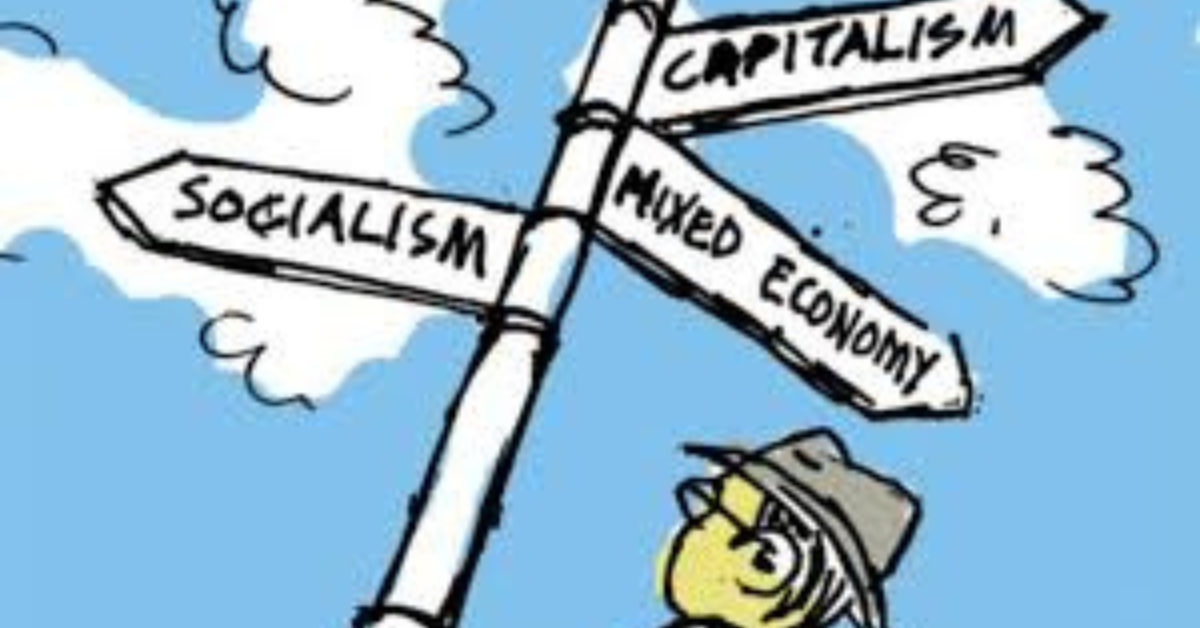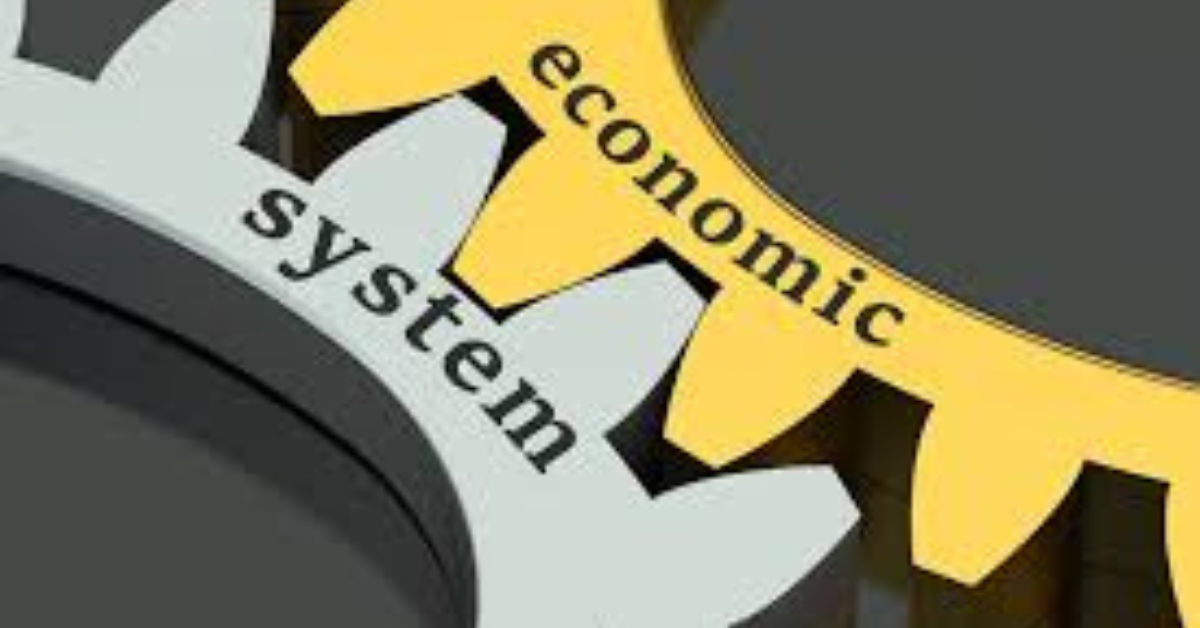A monetary framework fills in as the groundwork of a general public, forming its development, improvement, and, by and large, prosperity. It decides how assets are designated, labor and products are created, and abundance is circulated among people and organizations. Understanding the various sorts of monetary frameworks and their effects is critical to grasping the elements of worldwide economies.Lets start with my understanding “Economic System: The Backbone of a Society.”

Economic System: The Backbone of a Society
Key focal points:
- A monetary framework/economic system assumes a pivotal role in determining the success of a general public.
- Different financial frameworks, like free enterprise, communism, and blended economies, have particular standards and results.
- Monetary hypotheses and models give structures to examining financial frameworks and anticipating their way of behaving.
- The worldwide economy is interconnected, and monetary frameworks add to its general turn of events.
- Monetary strategies assume an imperative part in molding and keeping up with financial frameworks.
Understanding Economic Systems
A monetary framework/economic system is a construction that oversees the creation, dispersion, and utilization of labor and products inside a general public. It is the establishment whereupon a country’s economy is fabricated and can extraordinarily impact the general prosperity of its residents. This part intends to give a thorough comprehension of various financial frameworks, including free enterprise, communism, market economies, and blended economies, and investigate their effect on monetary turn of events.
Free enterprise
Free enterprise is a market-based financial framework that underlines private proprietorship, unrestricted economies, and the quest for benefit. In an entrepreneur economy, people and organizations have the opportunity to settle on their own monetary choices, for example, what to deliver, how to create it, and at what cost to sell. The opposition among purchasers and dealers impacts costs and designates assets proficiently. Free enterprise advances development, business, and monetary development, yet its emphasis on individual achievement can prompt pay disparity and lopsided appropriation of abundance.
Communism
Communism, then again, is a state-driven monetary framework in which the public authority claims and controls the method for creation. The principal objective of communism is to advance social equity and guarantee that abundance and assets are appropriated all the more fairly among the populace. In a communist economy, monetary choices are made by and large and are directed by the requirements of society in general. While communism intends to lessen pay inconsistencies and offer fundamental types of assistance to all residents, it can smother individual drive and business.
Market Economy
A market economy is described by the decentralized trade of labor and products through communications among purchasers and dealers. Not entirely settled by the powers of market interest, and assets are allotted in view of purchaser inclinations. Market economies consider a serious level of individual opportunity and advance contest, effectiveness, and development. In any case, unregulated business sectors might prompt market disappointments, like syndications, externalities, and inconsistent dissemination of assets.
Blended Economy
A blended economy joins components of both market influences and government intercession. It looks to find some kind of harmony between market-driven productivity and the requirement for government oversight and guidelines. In a blended economy, the public authority assumes a huge part in regions, for example, foundation improvement, social government assistance projects, and market guidelines. Blended economies mean to advance contests, safeguard shopper privileges, and guarantee fair admittance to fundamental administrations. In any case, finding the right harmony between market opportunity and government mediation can be a challenge.
“A blended economy considers both the dynamism of business sectors and the empathy of social security nets.”
– Angela Merkel

Understanding the qualities and shortcomings of various financial frameworks is urgent for policymakers and people alike. It empowers us to fundamentally break down their effect on monetary turn of events, pay conveyance, social government assistance, and generally speaking cultural prosperity. By concentrating on the different financial frameworks, we can take a stab at a more comprehensive, feasible, and prosperous future.
| Economic System | Principles | Strengths | Weaknesses |
| Capitalism | Private ownership, free markets, profit-driven | Promotes innovation, entrepreneurship, and economic growth | Income inequality, wealth concentration |
| Socialism | State ownership, collective decision-making | Reduced income disparities, equitable resource distribution | Limited individual initiative, potential for inefficiency |
| Market Economy | Decentralized exchange, supply and demand | Individual freedom, competition, and efficiency | Market failures, unequal resource distribution |
| Mixed Economy | Combines market forces and government intervention | Promotes competition, consumer protection, and social welfare | Challenges in finding the right balance |
By breaking down the qualities and shortcomings of each financial framework, we can more readily figure out their suggestions and take a stab at a more comprehensive, feasible, and prosperous society. The following area will investigate the different monetary speculations and models that shape how we might interpret financial frameworks and their elements.

Economic System Hypotheses and Models
Understanding the fundamental standards and instruments of monetary frameworks requires a thorough investigation of different financial speculations and models. These hypotheses and models are essential apparatuses for market analysts to dissect and anticipate monetary results, offering significant experiences into the working of various financial frameworks and their effect on social orders.
One of the major financial hypotheses is market interest, which investigates the connection between the accessibility of labor and products (supply) and purchaser interest. It represents how market influences connect to decide balance costs and amounts in a serious market.
“The cooperation of the organic market resembles an imperceptible hand that directs the distribution of assets in a market economy.” – Adam Smith
One more powerful monetary hypothesis is Keynesian financial aspects, created by John Maynard Keynes during the Economic crisis of the early 20s. This hypothesis proposes that administration intercession, like monetary arrangement, can balance out financial vacillations and advance financial development.
Neoclassical financial aspects, then again, stresses the significance of individual customer and maker conduct in forming the general economy. It investigates ideas, for example, objective direction, utility expansion, and the job of impetus in financial dynamic cycles.
Financial models act as insightful systems that mimic and work on certifiable monetary peculiarities, permitting business analysts to make forecasts and strategy suggestions. These models are based upon hypothetical suppositions and integrate different monetary factors to address the intricacies of financial frameworks.
Here is an illustration of a basic monetary model, the amount hypothesis of cash:
Variable Definition
M Money supply
V Velocity of cash
P Price level
Y Real yield (Total national output)
The amount hypothesis of cash expresses that the result of cash supply (M) and the speed of cash (V) is equivalent to the result of the cost level (P) and the genuine result (Y). This model assists financial analysts with understanding the connection between cash supply, expansion, and monetary action.
All in all, monetary speculations and models assume an imperative role in forming how we might interpret financial frameworks. They give significant bits of knowledge into the elements of the organic market, the effect of government intervention, and the way people and firms behave inside the economy. By using these instruments, market analysts can make informed forecasts and strategy suggestions to cultivate financial development and solidity.

The Worldwide Economy
In the present interconnected world, the worldwide economy assumes a crucial part in forming the financial improvement of countries. The nearby ties between various economies make an organization of monetary reliance, where the activities and strategies of one nation can affect others. Understanding the elements of the worldwide economy is fundamental for policymakers, organizations, and people to explore the intricacies of the cutting edge monetary scene.
One of the critical drivers of the worldwide economy is global exchange. The trading of products, administrations, and capital across borders energizes financial development and cultivates specialization, permitting nations to use their relative benefits. Worldwide exchange advances proficiency, spikes development, and extends market potential, opening doors, to both developed and agricultural countries.
Financial reliance is a main trait of the worldwide economy. Countries depend on one another for assets, fabricating abilities, and admittance to new business sectors. Disturbances in a single region of the planet can have expanding influences all through the worldwide store network, featuring the unpredictable trap of associations that support monetary exercises.
“The worldwide economy is a complicated and interconnected framework. Changes in monetary approaches or economic situations in a single nation can have overflow consequences for other people, featuring the requirement for collaboration and coordination among countries.”
Financial strategies likewise assume a critical part in territorial and worldwide monetary development. States execute approaches that intend to invigorate financial action, advance ventures, and encourage development. These arrangements can take different structures, for example, financial upgrade bundles, money related measures, and primary changes.
The worldwide economy isn’t without challenges. Financial inconsistencies, exchange awkward nature, and international strains can create instability and vulnerability. Nonetheless, through joint effort and powerful strategies, nations can pursue accomplishing a more steady and comprehensive worldwide monetary framework.

The Effect of Monetary Frameworks on the Worldwide Economy
Financial frameworks, like private enterprise, communism, and blended economies, contribute altogether to the worldwide economy. Every framework has its assets and shortcomings and decides the degree of government intercession, the job of business sectors, and the appropriation of assets.
Private enterprise, portrayed by confidential proprietorship, unrestricted economies, and benefit driven impetuses, has been a prevailing financial framework forming the worldwide economy. Entrepreneur economies depend on market influences to apportion assets and drive advancement, bringing about productivity and abundance creation. In any case, reactions of private enterprise incorporate pay imbalance and the potential for market disappointments that can prompt monetary differences.
Communism, then again, underscores aggregate possession, arranged economies, and redistributive approaches. Communist economies focus on friendly value and the arrangement of fundamental labor and products. Nonetheless, some contend that the absence of market components in communist frameworks can thwart advancement and financial effectiveness.
Blended economies work out some kind of harmony between market influences and government intercession. These frameworks consolidate components of both private enterprise and communism, considering the advantages of market elements while tending to social government assistance concerns. Blended economies give government oversight and guidelines to moderate market disappointments and advance social value.
| Economic System | Characteristics | Advantages | Disadvantages |
| Capitalism | Private ownership, free markets, profit-driven incentives | Efficiency, innovation, and wealth creation | Income inequality, potential market failures |
| Socialism | Collective ownership, planned economies, and redistributive policies | Social equity, provision of essential goods and services | Lack of market mechanisms, potential for inefficiency |
| Mixed Economy | Combination of market forces and government intervention | Balance between market dynamics and social welfare | Challenges in finding the right balance, potential for conflicting interests |
Capitalism: A Market-Based Economic System
Private enterprise is a market-based financial framework that underlines the standards of unregulated economies, confidential proprietorships, and benefit driven impetuses. Under private enterprise, people and organizations participate in willful exchanges to trade labor and products, with restricted government mediation.
One of the critical benefits of free enterprise is its capacity to advance financial turn of events. The serious idea of unrestricted economies empowers development, effectiveness, and efficiency, prompting in general financial development. Furthermore, private enterprise encourages business and empowers people to seek out financial opportunities and gather riches.
Nonetheless, free enterprise isn’t without its drawbacks. The quest for benefit can now and again prompt pay disparity and abundance fixation. Pundits contend that free enterprise might bring about abuse of work and natural corruption, as benefit expansion turns into the essential concentration.
“The innate bad habit of free enterprise is the inconsistent sharing of favors; the inborn uprightness of communism is the equivalent sharing of agonies.” – Winston Churchill
Regardless of its disadvantages, free enterprise plays had a critical impact in driving financial improvement. It has been essential in forming economies like those of the US, Joined Realm, and Singapore. In any case, the effect of private enterprise on monetary improvement is affected by the execution of financial arrangements.
Financial strategies, like tax collection, guidelines, and government assistance programs, assume an imperative role in forming an entrepreneurial economy. These strategies expect to guarantee fair rivalry, safeguard shoppers, and give a security net to weak people. Viable monetary strategies can upgrade the positive parts of free enterprise while relieving its unfortunate results.
Table: Benefits and Hindrances of Private enterprise
Benefits of Capitalism Disadvantages of Free enterprise
Financial development and development Income imbalance
Development and entrepreneurship Exploitation of work
Effectiveness and productivity Environmental corruption
Individual financial freedom Lack of social security nets
Source: Information arranged from different insightful sources.
All in all, private enterprise is a market-based financial framework that enjoys the two benefits and hindrances. It plays a huge impact in driving monetary improvement worldwide but at the same time is dependent upon analysis in regards to pay disparity and work double-dealing. The execution of powerful financial arrangements is significant in forming and bridling the positive parts of free enterprise while tending to its weaknesses.
 Socialism: A State-Driven Economic System
Socialism: A State-Driven Economic System
Communism is a monetary framework portrayed by aggregate responsibility for method for creation and focal preparation. In a communist economy, the state assumes a focal part in overseeing assets and rearranging abundance to advance social government assistance and financial equity. While communism enjoys its benefits and hindrances, it is pivotal to comprehend its effect on monetary turn of events and the job of financial strategies in carrying out and dealing with a communist framework.
Standards of Socialism
In communism, the essential rule is the aggregate responsibility for ventures and assets by the state or people in general. This guarantees that abundance and assets are dispersed all the more impartially among all citizens. Moreover, focal arranging is utilized to facilitate creation, estimating, and asset designation.
Benefits of Socialism
- Monetary Fairness: Communism means to diminish pay disparity and give equivalent open doors to all citizens.
- More noteworthy Social Government assistance: With an emphasis on open proprietorship, communism frequently focuses on friendly government assistance projects like medical services, instruction, and public foundations.
- Security: Focal arranging considers better coordination and dependability inside the economy, diminishing the unpredictability found in market-based frameworks.
Disadvantages of Socialism
- Absence of Development: Focal arranging might smother advancement and enterprising soul, as choices are made by the state as opposed to the market.
- Diminished Impetuses: With aggregate possession, people might miss the mark on the same degree of inspiration and motivators to try sincerely and succeed in their undertakings.
- Restricted Opportunity: The state’s command over assets and navigation might limit individual flexibilities and independence.
Impact on Economic Development
As far as monetary turn of events, communism has made fluctuating levels of progress in various nations. While communist frameworks have focused on friendly government assistance and decreased pay imbalance, they have additionally confronted difficulties in advancing productive asset portion and animating development. Fruitful monetary improvement under communism frequently depends on viable financial arrangements, including cautious preparation, interest in foundation, and offsetting abundance reallocation with motivations for efficiency.
Country Economic Development Key Strategies
Sweden High expectation for everyday comforts, low destitution rates Strong social security nets, moderate tax collection
Venezuela Economic flimsiness, high inflation Heavy state control, unnecessary dependence on oil incomes
Cuba Universal medical care, high proficiency rates State control of significant enterprises, restricted private area
Mixed Economy: Balancing Market Forces and Government Intervention
A blended economy is a monetary framework that consolidates components of both market influences and government mediation. In a blended economy, the public authority and the confidential area coincide, each assuming a pivotal part in molding the economy and guaranteeing its solidness and development.
In a blended economy, market influences drive most of monetary exercises, permitting organizations and people to settle on free choices in view of the organic market. This advances contest, development, and effectiveness, prompting monetary development and flourishing. Market economies energize business and confidential possession, furnishing people with the potential chance to seek after their undertakings and expand their benefits.
Notwithstanding, a simple market-based framework can prompt imbalances and market disappointments. That is where government mediation becomes possibly the most important factor. The public authority’s job in a blended economy is to direct and manage monetary exercises, guaranteeing fair contests, buyer security, and social government assistance.
One of the critical standards of a blended economy is the foundation of guidelines and strategies to forestall the maltreatment of market power and safeguard the interests of people in general. These guidelines can incorporate antitrust regulations, work norms, and natural guidelines. By executing these actions, the public authority means to keep a level battleground and forestall monopolistic way of behaving.
Moreover, the public authority in a blended economy likewise gives public labor and products that are fundamental for the prosperity of society in general. These public merchandise can incorporate foundation improvement, medical care, training, and public security. By putting resources into these areas, the public authority guarantees that all residents approach essential conveniences and open doors, adding to social government assistance and a comprehensive economy.
“A blended economy takes into consideration the advantages of both market influences and government mediation. It finds some kind of harmony between individual opportunity and social obligation, giving a climate where organizations can prosper while likewise tending to cultural requirements.” – John Smith, Financial expert
Like any financial framework, a blended economy enjoys its benefits and inconveniences. One of the principal benefits is its capacity to advance both monetary development and social government assistance. By consolidating market elements and government mediation, a blended economy can make a more fair society where potential open doors are available to all.
Be that as it may, the viability of a blended economy relies vigorously upon the public authority’s monetary strategies. The public authority should cautiously adjust its mediation to try not to smother advancement and efficiency. Overregulation or exorbitant government control can prompt shortcomings and beat private area investment, obstructing monetary development down.
In rundown, a blended economy offers a split the difference between market influences and government mediation. It uses the qualities of the two ways to deal with making a dynamic and comprehensive monetary framework. By executing successful monetary strategies, a blended economy can drive a reasonable turn of events and further develop the general prosperity of society.
Benefits of a Blended Economy Disadvantages of a Blended Economy
- Advances financial development and advancement through market dynamics. 1. Chance of overregulation and extreme government control.
- Makes progress toward social government assistance by giving public merchandise and services. 2. Potential for shortcomings and administration.
- Balances individual opportunity and social responsibility. 3. Requires powerful financial approaches for ideal results.
 Economic Policies: Tools for Shaping Economic Systems
Economic Policies: Tools for Shaping Economic Systems
With regards to forming different monetary frameworks, financial strategies assume an essential part. These approaches act as core values and procedures that legislatures utilize to successfully deal with their economies. By carrying out and authorizing financial arrangements, nations can impact the working, development, and advancement of their monetary frameworks.
There are different kinds of financial approaches that state run administrations use to shape their monetary frameworks. These arrangements include:
- Fiscal strategy: Financial approach includes the public authority’s choices with respect to tax assessment and public consumption. It plans to impact the general interest, spending, and speculation designs in the economy. Through monetary arrangement, legislatures can change charge rates, government spending, and acquiring to animate financial development or control expansion.
- Monetary strategy: Financial approach alludes to the moves initiated by national banks to deal with the cash supply, loan fees, and credit inside an economy. By changing loan costs and change
A Comparison of Economic Policies in Different Economic Systems
Financial System Economic Strategies
Market Economy • Promotion of rivalry
- Insurance of property freedoms
- Insignificant government intercession
Blended Economy • Regulation of business sectors
- Government arrangement of public merchandise
- Social wellbeing nets and government assistance programs
Socialism • Central arranging and designation of assets
- Libertarian dissemination of riches
- State responsibility for ventures
The table above gives a compact examination of the financial strategies utilized in various monetary frameworks. It features the key strategy needs and targets of every framework, underlining their special ways to deal with forming the economy.
Financial Turn of events: A Proportion of Progress
Financial improvement is a critical mark of a general public’s advancement and thriving. It alludes to the supported expansion in a country’s for every capita pay, improvement in expectations for everyday comforts, and generally prosperity of its residents. The way to financial advancement shifts relying upon the basic monetary framework set up. How about we investigate the monetary improvement accomplished under various financial frameworks: private enterprise, communism, and blended economies.
Free enterprise and Financial Turn of events
In an entrepreneur framework, the quest for benefit and unregulated economy rivalry drive financial turn of events. Free enterprise energizes business, development, and interest in useful assets. By giving people chances to collect riches, free enterprise boosts monetary development. Notwithstanding, it additionally has its drawbacks, like pay disparity and potential market disappointments. Powerful monetary strategies, for example, guidelines and social security nets, are fundamental for supporting financial improvement inside an industrialist structure.
Communism and Financial Turn of events
Communism, then again, centers around aggregate proprietorship and the evenhanded circulation of assets. This financial framework expects to guarantee civil rights and take out imbalances. While communism elevates equivalent admittance to schooling, medical care, and social administrations, its effect on monetary advancement changes. Focal preparation and government control can smother development and business venture, blocking monetary development. In any case, fruitful communist economies have shown eminent accomplishments in regions like schooling, medical care, and neediness decrease.
 Blended Economy: Adjusting Market Influences and Government Mediation
Blended Economy: Adjusting Market Influences and Government Mediation
A blended economy consolidates components of both private enterprise and communism, finding some kind of harmony between market influences and government mediation. This framework considers private responsibility while likewise giving unofficial law and social government assistance programs. Blended economies expect to accomplish the advantages of both free enterprise and communism, advancing financial development close by friendly value. The progress of a blended economy depends on viable financial strategies that oversee market disappointments, guarantee fair contests, and address social requirements.
Contrasting Monetary Advancement Pointers
How about we look at financial improvement pointers for each monetary framework:
Financial System Gross Homegrown Item (Gross domestic product) per capita Major Monetary Accomplishments
Capitalism High Innovation, mechanical headways, and elevated degrees of private venture
Socialism Varies Universal medical care, high proficiency rates, decreased pay disparity
Blended Economy Moderate Combination of private and public administrations, adjusted way to deal with financial development and social government assistance
It’s critical to take note of that monetary advancement is not entirely set in stone by the financial framework but in also affected by different factors like normal assets, political soundness, training, and foundation.
In general, monetary improvement is a complicated cycle impacted by the financial framework, strategies, and outside factors. Each monetary framework has its assets and shortcomings in cultivating financial development and social prosperity. The critical lies in finding some kind of harmony and carrying out viable financial arrangements that advance practical turn of events and address social worries.

Economic Systems and Social Equity
One of the major parts of any financial framework is its effect on friendly value. Different monetary frameworks, including private enterprise, communism, and blended economies, move toward this issue in particular ways.
While dissecting the impacts of private enterprise on friendly value, taking into account its accentuation on unrestricted economies and confidential ownership is significant. Private enterprise advances individual monetary opportunity and boosts advancement and business ventures, prompting financial development and improvement. Nonetheless, pundits contend that private enterprise can fuel pay imbalance and cause aberrations in abundance dispersion. The quest for benefit might focus on the interests of the rich, abandoning underestimated gatherings.
Then again, communism means to address social value by underscoring aggregate possession and arranged economies. By rearranging abundance and assets, communism tries to decrease pay variations and give equivalent open doors to all. Be that as it may, the unified idea of communist frameworks can restrict individual monetary opportunity and prevent impetuses for advancement and business ventures.
Blended economies, as the name suggests, consolidate components of both private enterprise and communism. These economies mean working out some kind of harmony between market influences and government mediation. By carrying out friendly government assistance projects and guidelines, blended economies try to diminish social disparity and keep up with financial strength. Nonetheless, finding the right harmony between market elements and government control can be a fragile errand.
Financial strategies assume a significant part in molding social value inside various monetary frameworks. Legislatures can execute moderate duty frameworks, the lowest pay permitted by law regulations, and social wellbeing nets to relieve pay incongruities and guarantee a more fair society. Also, putting resources into training, medical care, and foundation can cultivate social versatility and empower people to conquer fundamental hindrances.
“The trial of our advancement isn’t whether we add more to the overflow of the individuals who have a lot; it is whether we give enough to the people who have nearly nothing.” – Franklin D. Roosevelt
Generally speaking, achieving social value requires an exhaustive comprehension of the qualities and shortcomings of various financial frameworks. It requires insightful monetary approaches that address pay appropriation, destitution lightening, and social versatility. By stepping toward a general public that values both success and reasonableness, we can make an economy that helps every one of its individuals.
Monetary System Approach to Social Value
Capitalism Promotes financial opportunity and advancement yet may prompt pay disparity
Socialism Emphasizes aggregate proprietorship and abundance rearrangement yet can restrict individual monetary opportunity
Blended Economy Strives for a harmony between market influences and government mediation to lessen social disparity

The Evolution of Economic Systems
In the constantly changing scene of human civilization, financial frameworks play had an imperative impact in forming the flourishing and progress of social orders. Since forever ago, these frameworks have gone through wonderful development, adjusting to the necessities and intricacies of various periods. From the ascent of antiquated market economies to the rise of current entrepreneur and communist frameworks, the advancement of monetary frameworks mirrors the unique idea of human undertakings.
One of the earliest types of monetary frameworks can be followed back to old civic establishments like Mesopotamia and Egypt, where a bargain framework worked with exchange and financial exchanges. As social orders extended and complexified, market economies emerged, driven by the trading of labor and products through a decentralized commercial center. These market-based frameworks took into consideration more noteworthy specialization and worked with financial development.
“The old civilizations of Mesopotamia and Egypt embraced a deal framework to empower exchange and financial exchanges.” – Dr. Samantha Jenkins, Financial History specialist
In any case, as industrialization cleared across countries, new financial frameworks arose. Private enterprise acquired unmistakable quality during the Modern Upheaval, with its accentuation on confidential possession and unregulated economies. Free enterprise energized advancement, business venture, and monetary development, yet in addition prompted pay variations and social imbalances.
In the interim, communism arose as a reaction to the unfriendly impacts of free enterprise, trying to address social disparities through aggregate proprietorship and state control. Communist frameworks planned to focus on friendly government assistance, however frequently confronted difficulties regarding monetary productivity and motivation structures.
Perceiving the qualities and shortcomings of both free enterprise and communism, numerous social orders embraced blended economies, joining components of market influences and government mediation. Blended economies try to work out some kind of harmony between individual opportunities and aggregate liability, utilizing the advantages of the two frameworks.
Examples from An earlier time, Dreams for What’s to come
The development of monetary frameworks offers significant examples for molding what’s to come. By investigating the triumphs and disappointments of past frameworks, policymakers and financial analysts can create more viable structures for monetary turn of events and cultural prosperity.
Headways in innovation, globalization, and ecological difficulties are driving the need to reconsider and reclassify financial frameworks. As social orders take a stab at feasible turns of events and impartial results, monetary frameworks should adjust to address these squeezing concerns.
The interconnectedness of the worldwide economy requires coordinated effort and participation among countries to handle shared difficulties. Whether it is in relieving environmental change, decreasing destitution, or advancing comprehensive development, financial frameworks should line up with the objective of aggregate advancement.
Diagramming the Course Ahead
The eventual fate of financial frameworks lies in finding some kind of harmony between monetary

FAQ
A monetary framework alludes to the construction and association of an economy, including the creation, conveyance, and utilization of labor and products inside a general public. It incorporates the arrangements, organizations, and instruments that shape monetary exercises and decide the distribution of assets.
What are the various kinds of financial frameworks?
The fundamental kinds of financial frameworks are private enterprise, communism, and blended economies. In an entrepreneur framework, the methods for creation are exclusive, and financial choices are driven by market influences. In a communist framework, the methods for creation are all claimed, and monetary choices are halfway arranged. Blended economies consolidate components of both market influences and government interference, with changing levels of guidelines and public proprietorship.
What are monetary hypotheses and models?
Financial hypotheses are structures that dissect and make sense of the way of behaving and connections of monetary specialists, like people, firms, and legislatures. Financial models, then again, are improved on portrayals of reality used to comprehend and foresee monetary peculiarities. They depend on suppositions and numerical connections to reproduce the activities of the economy.
How does the worldwide economy function?
The worldwide economy is an interconnected organization of financial exercises and exchanges that happen among countries. It includes the trading of products, administrations, capital, and data across borders. Monetary frameworks assume an essential role in driving the worldwide financial turn of events, with exchange, venture, and monetary strategies forming the development and success of nations all over the planet.
What is free enterprise, and how can it affect the financial turn of events?
Free enterprise is a market-based monetary framework described by confidential responsibility for method for creation and the quest for benefit. It cultivates rivalry, advancement, and venture, which can drive financial development and improvement. Nonetheless, free enterprise likewise causes difficulties such as pay disparity and market instability, which require compelling financial strategies to address.
What is communism, and how can it affect the financial turn of events?
Communism is a state-driven financial framework described by aggregate responsibility for method for creation and an emphasis on friendly government assistance. It plans to advance monetary balance and civil rights. While communism can give more noteworthy social insurance, it might confront difficulties like shortcomings and restricted individual opportunities. To actually carry out communism, cautious financial preparation and strategies are vital.
What is a blended economy, and how can it function?
A blended economy consolidates parts of market influences and government intervention. It includes private responsibility for assets and businesses, however, the public authority assumes a critical part in directing and giving public labor and products. Blended economies expect to offset market productivity with social government assistance. Financial strategies, like guidelines and tax collection, are utilized to keep up with this equilibrium.
How do monetary strategies shape financial frameworks?
Monetary strategies assume an urgent part in molding financial frameworks by impacting the way of behaving of financial specialists and the portion of assets. They can incorporate financial arrangements, (for example, tax collection and government burning through), money related approaches, (for example, loan fee changes), exchange strategies (like levies and endowments), and social government assistance arrangements (like medical services and schooling). Financial approaches guarantee the workings and strength of monetary frameworks.
How is financial advancement estimated?
Monetary advancement is estimated using different pointers, including GDP (Gross domestic product), pay per capita, joblessness rates, destitution levels, and human improvement records. These markers evaluate the general monetary prosperity of a general public, including elements like financial development, way of life, and access to essential necessities like instruction and medical care.
How do monetary frameworks address social value?
Different monetary frameworks address social value in different ways. Free enterprise centers around individual drive and market-driven abundance creation, yet pay disparity can be a test. Communism accentuates evenhanded dissemination of assets and social government assistance, expecting to limit disparity. Blended economies endeavor to offset market effectiveness with social value through the execution of monetary approaches that advance reasonableness and inclusivity.
How have monetary frameworks advanced over the long run?
Monetary frameworks have developed from the beginning of time in light of cultural changes, mechanical progressions, and worldwide difficulties. From early agrarian social orders to feudalism, mercantilism, and the modern unrest, financial frameworks have adjusted and changed. Illustrations gained from past frameworks have molded the improvement of current financial speculations and models, illuminating policymakers on the best way to explore contemporary monetary difficulties and advance a feasible turn of events.





